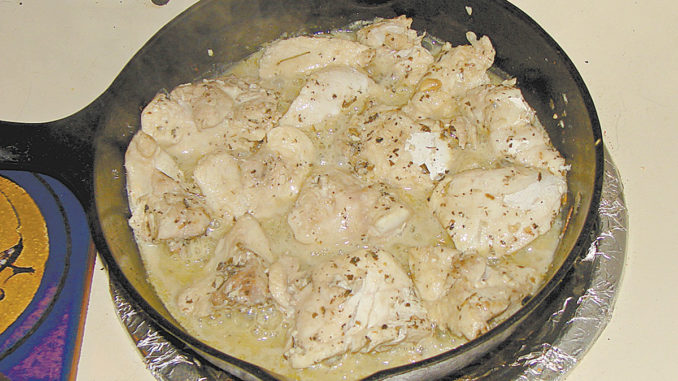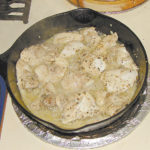
Unusual part of tasty fish can make great meal
The summer and early fall have been unusual, with lots of rain early, followed by near-drought conditions along the coast and then lapsing into weeks of windy weather that made fishing difficult at best — and then the monsoon. One thing has been consistent: offshore bottom-fishing has been really good to excellent. Even those new to the specifics of finding and wrangling large bottom-dwellers from their homes in wrecks and sea-floor rocks formations have been catching most species well. Experienced fishermen have caught enough many days they have cleaned fish well into the evening.
Grouper are considered by most to be the prime target for most fishermen. All the other tasty bottom-dwelling fish are considered extras or incidental catches. A word to the wise would be not to overlook the other species in your quest for grouper. Many of them are excellent table fare but require slightly different methods of preparation to better accentuate the textures and flavors of their meat.
However, this month’s recipe is about grouper, and this preparation will make for tasty fillets, but it is one my wife Donna put together specifically to prepare the cheeks of grouper. Regular readers will recall that several months ago, the featured recipe was for grouper throats. Most larger fish have throats and cheeks that can be prepared in a variety of tasty ways, and they are mild, like their fillets. If you like grouper, you’ll want to get the most of it, and those throats and the cheeks used here are pieces of meat that are often overlooked and discarded simply because people don’t know how good they can be. That’s a mistake that hopefully you won’t make again after trying this simple recipe.
I know a lot of you prepared the grouper throats because some e-mailed and others stopped me in tackle shops and marinas to ask about it. I said I would be following up in a few months with a recipe for grouper cheeks, and this is one of several. I had a difficult time choosing between this and another recipe, so I’ll feature the other in late spring when grouper season reopens after the annual winter closure.
Yep, grouper season has a winter closure to protect spawning aggregations. The closure begins at 12:01 a.m. on Jan. 1 and runs until 12:01 a.m. on May 1. If the closing date has slipped up on you, this recipe might be enough to prompt you to make another trip or two for some fresh grouper before it closes. You’ll have the fillets and steaks, plus a package or two of cheeks.
Grouper is a mild-flavored meat and freezes surprisingly well, so if you catch everyone’s limit, there can be plenty for several special meals while the winter wind is swirling. I believe you’ll find this recipe will be the base for at least one of those special meals. It will be a good one to break the monotony of leftover turkey late in the month.
Sautéed grouper cheeks
This is one of the simplest recipes ever in this column, and I believe it is one of the best. There are a couple of ingredients that must be mixed to make the marinade, but after that it’s a simple matter of cooking it without overcooking it.
Herbes de Province is a generic term used to describe a blend that includes savory, marjoram, rosemary, thyme, oregano, lavender and other herbs. It originally referred to herbs found in the southern provinces of France. Herbes de Province is sold as a blend and should be easy to find in the spice section of your supermarket.
The uniqueness of this recipe is that it uses a part of the fish I am constantly surprised to find out people don’t know is there. Not all fish have cheeks, but many medium to large ones do. The cheeks are pieces of meat on the fish’s face, above the mouth and below the eyes.
My first experience with fish cheeks was many years ago while deer hunting at Camp Opportunity in Ohio. Capt. Ottie Snyder ran the camp for Horton Crossbows during the winter and guided for walleye on Lake Erie during the summer. He would save the cheeks of any walleye his charters couldn’t or didn’t take with them and bring it to the camp for special meals. After a meal of walleye cheeks one year, I returned with dolphin fillets and oysters as my next contribution.
Capt. Ottie introduced me to walleye cheeks that he sautéed in a little olive oil with peppers and onions, and they were some kind of good. It was an awakening to me. I grew up in a commercial-fishing family eating what we couldn’t sell. I have eaten a variety of fish that weren’t and still aren’t considered the best, but we never had cheeks. What a mistake.
Since being introduced to fish cheeks, I have looked at a wide variety of fish for cheeks and most have them. They range from small morsels in some fish to nice medallions in larger ones. Grouper cheeks are my favorites, as there are some pretty nice pieces of meat and they are as mild as the prime fillets. Once you do it a time or two, grouper cheeks are easy to pop out with a sharp fillet knife. It takes more than a single fish to prepare a meal, but two fishermen’s limits will usually give a good meal.
This is a mild recipe developed by my wife, Donna. She likes her fish prepared with less spices than I do and I thought this might be a good break for some of you readers. The marinade has just a few ingredients and uses the lemon juice to break down the fish and the oil, garlic, salt and spice blend to build a mild flavor that saturates it and keeps it moist while cooking.
I prepared this batch inside on the stove, but if it is a mild evening, it can also be cooked on the grill or an accessory burner. It isn’t like blackening and only requires medium heat. The biggest concern when cooking is to be sure not to overcook it. You won’t like it if cooked until it dries out.
I really like this and am certain that if you prepare this once, you will eat it again. This recipe is simple and tasty and the most difficult part is finding the grouper cheeks. Some fish markets carry them, but catching the grouper yourself and popping out the cheek morsels is the best — and most fun — way. Enjoy!
INGREDIENTS:
1 pound of grouper cheeks
Juice of 1 lemon
1 tsp minced garlic
1/2 tsp kosher salt
1 tsp Herbes de Province
Drizzle of olive oil
PREPARATION:
Mix lemon juice, garlic, kosher salt, Herbes de Province and olive oil well and put in Zip-Lock bag. Add the grouper cheeks to the bag and turn several times to spread marinade over all the pieces. Squeeze all the air out of the bag, seal and marinate grouper cheeks for 30 minutes.
Pour the marinade from the bag into a cast-iron skillet and pre-heat on medium. When the marinade begins to bubble, add the grouper cheeks to the pan. Cook the grouper cheeks for 4 minutes and turn. Finish cooking the grouper cheeks to your preferred level of doneness. Be careful not to overcook.
I like to serve grouper cheeks with simple sides. If you put up some corn on the cob during the summer, this is an excellent time to use a few of them. A green salad and fresh, warm, hearty bread make this a light, but filling meal. If you want it to be a little more filling, substitute a baked sweet potato for the corn.





